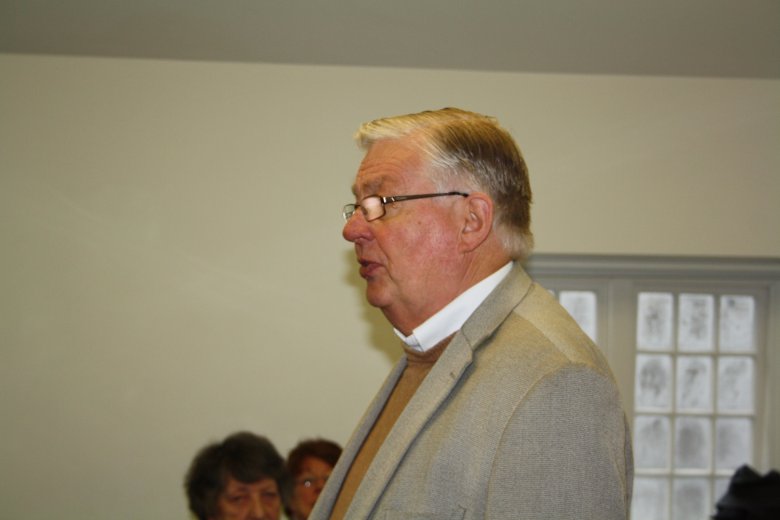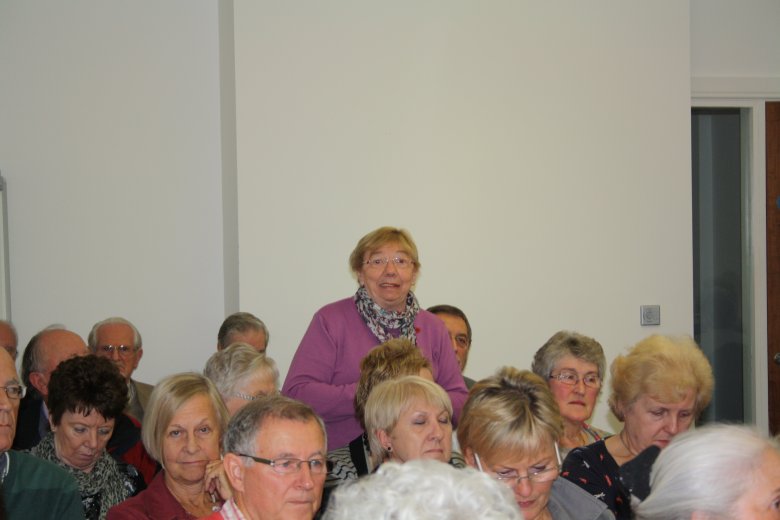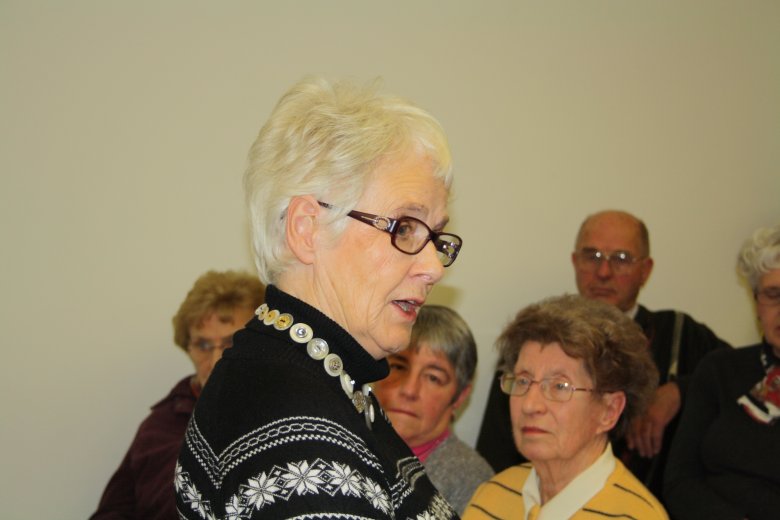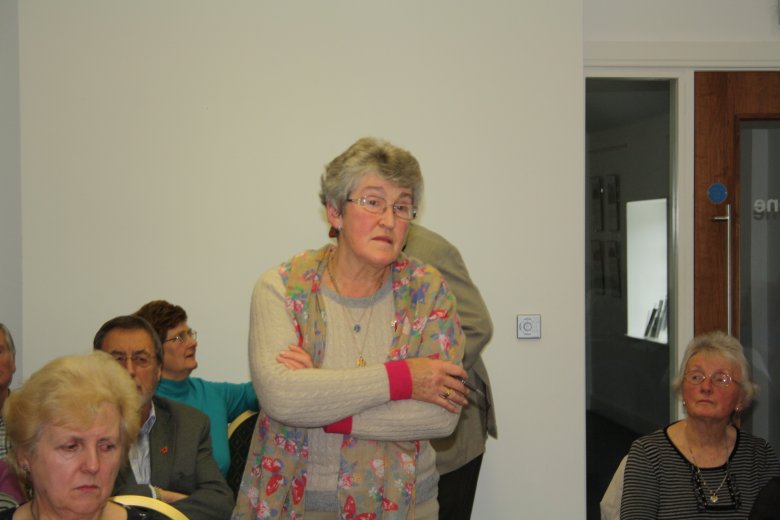Report of the Annual General Meeting – 8 November 2014
By Pat Devlin
| Introduction
The AGM was held in Clotworthy House in the grounds of the former Antrim Castle. It is a modern, well appointed venue. The attendance was the best in many years, with nearly 60 people attending. The accommodation was adequate if a bit cramped. Johnny Dooher welcomed the delegates with special greeting for Dick Ryan, the Chair of the Federation of Local History Societies, and his wife Helen. The two Federations had been working closely together for the last number of years and he hoped that this would continue for the foreseeable future. Bridgeen Rutherford presented her Secretary’s Report, taking the meeting through the Federations activities since the last AGM, including the two seminars; Divided Loyalties in Armagh and Hidden Histories (jointly with the FLHS) in Dundalk. Also mentioned were the Hidden Gems project, the Speakers’ Guide and the People and Places Project. Bridie Bradley presented her first Financial Report as Treasurer, taking the meeting through the details of the Federation’s income and expenditure and its recent registration as a charity with the new Charities Commission NI. All Societies would eventually receive an invitation to register and the Federation would be available to help Societies if needed. |
 |
 |
 |
 |
 |
|
Presenting his Chairman’s Report, Johnny Dooher thanked all those who had worked for the success of the Federation. The Executive Committee needed to be strengthened and he called on Societies to help by identifying and encouraging members to agree to being co-opted so as to gain experience of the roles. The Executive needed to know what it was that Societies wanted and needed from the Federation. The original purpose was to bring together different local societies to share work and experience and we needed to get this going again. Federation attendance at the recent seminars had been poor, about six societies represented. The seminars had been high quality and good value for money so why was there so little interest. We don’t know. Perhaps the information wasn’t getting to the individual members. Perhaps we needed to make more use of social media like Facebook and Twitter.
Johnny reported good working relationships with the Federation of Local History Societies had continued to prosper with regular joint meetings and several annual planned trips in Ireland and further afield. Johnny concluded with a tribute to the late Bill Crawford, Federation Treasurer following its formation and its Development Officer from 1993 to 1997. There was an Appreciation of Bill’s achievements, by Trevor Parkhill, in the current edition of Due North. Dick Ryan, President of the FLHS presided over the elections of Officers and the Executive Committee. Afterwards he brought greetings from the Federation and said how much he enjoyed the joint events and of the many friendships that that been made and endured between so many of the members. He mentioned a seminar that the FLHS had organised earlier in the year to provide member societies with an opportunity to learn how to use Facebook and Twitter and this was already bearing fruit. He suggested that if it was thought useful a joint event on the same topics could be organised. |
|
 |
 |
| With the formal business of the AGM completed there was an opportunity for members to share ideas on how to make the Federation more relevant to its members and report on Society projects and activities. This is a relatively new development and on this occasion there was widespread participation. Patrick Cross, Lecale and Down, referring to the need for more participation, suggested the appointment of a liaison person in each society to ensure that the members received Federation communications. Helen Meehan, Donegal, considered that there were so many other activities now available that people were swamped with choices, this impacting on Federation events. | |
 |
 |
|
John Hulme, Carrickfergus mentioned some of the innovative projects being undertaken by societies such as the ‘Glenelly Our Home’ Facebook page. He suggested a combined Society Seminar to share experience, projects and activies as a starting point. This idea was taken up by a representative of Libraries NI who thought it was a great idea and very useful for people starting out.
A member of the Antrim Society mentioned a joint project with the Randalstown Society about the linen industry in the area and display of the project that was available here in the building. |
|
 |
 |
|
Doreen McBride, Banbridge, talked about the Society’s participation in the People and Places project that involved tracing part of the route of the old coach road from Loughbrickland to Hillsborough, and possible future cooperation with other societies to trace the route further toward Lisburn and back to the border.
Jennifer Cunningham, Coleraine, mentioned that this year was the Society’s thirtieth anniversary; it had produced 20 journals. The Society recognised the need to attract more and younger members. She would have liked to attend the People and Places seminar but it was too far in bad weather. She suggested that it would be useful to re-run it in other places. The Chairman replied that this could be done. |
|
 |
 |
|
A NIFHS member, Ballymena Branch, told the meeting about a DNA project in which he was engaged. The society had advice from experts in the field and was keen to get as many people involved as possible. With DNA information it was possible to trace ancestry back for thousands of years and it could reveal links with people, e.g. from Scotland, reflecting the movement of people over many centuries.
Patrick Greer, West Belfast, mentioned a joint project with the Belfast Civic Trust involving the preservation of Georgian Buildings . |
|
 |
 |
|
Margaret Cartwright, NIFHS and North Belfast, recommended the NIFHS library in Newtownabbey as a great source of information about people and ancestry. It was open to the public.
Florence Chambers, Banbridge, talked about a project to chart the history of an isolated local Orange Hall. This resulted in a book that was well received and to numerous requests for similar research for other Orange Halls and buildings. |
|
 |
 |
|
Pat McGuigan, Strabane, asked if anyone had approached schools about the possibility of arranging cooperation about local history in the Curriculum. This led to a lively discussion in which it was indicated that it was difficult for schools due to curriculum and testing pressures to add anything. Donegal still has some annual involvement but not as extensive as in past years.
The Chairman mentioned a recently started project in Strabane that involved going through the local newspapers week by week for the duration of WW1, identifying deaths. The intention was to try to find the relatives of the fallen and gather family memories and histories surrounding the war and their relative. It was a two-year project. Shirley Cochrane, Donaghadee, said that the society had set up a new website last year. The society had a number of projects. One concerned the local people who had survived the war; what happened to them, what were their stories? They had worked with the QUB Living Legends team involving the scanning and recording of historical documents provided by local people. The Society also had an oral history project involving the oldest inhabitants recording their memories which would be published. Donaghadee had obtained Townscape Heritage funding and the society was cooperating in researching the history of the buildings and developing an educational pack for use in the local schools. The society worked closely with the Family History Society and cooperated in joint projects, something she would recommend to other societies. |
|
 |
 |
|
Bill Canning, launching the 2014 edition of Due North, quoted Macaulay that ‘the history of a nation is in its newspapers’ and an excellent article in the journal showed their importance in researching local history. Due North was an excellent publication and always has been. Despite the growth of the internet there was still merit and joy in reaching for the printed publication which was always to hand. Nothing changes; in one of the articles here about WW1, concern was expressed about young girls being held in women’s prisons and just today there was a report on the radio about children in custody being held in inappropriate locations. As a Donegal man he was fascinated by cottage industries and in one of the articles about Arts and Crafts in Donegal he had been surprised to read that there had been lace schools in Donegal. He recommended the latest edition as worthy of the fullest support.
Eamon Phoenix, Guest Speaker, gave an informative, insightful and occasionally hilarious overview of the major personalities, events, activities and happenstances leading up to, during, and after WW1 in the context of the Ireland-wide Decade of Centenaries 1912 – 1923. The address was well received if the volume of the applause at its end is to be taken as the measure. After lunch the planned tour of the Castle gardens was curtailed by the atrocious weather. Overall however, the AGM was an outstanding success and a good basis for further development in and between member societies. |
|



